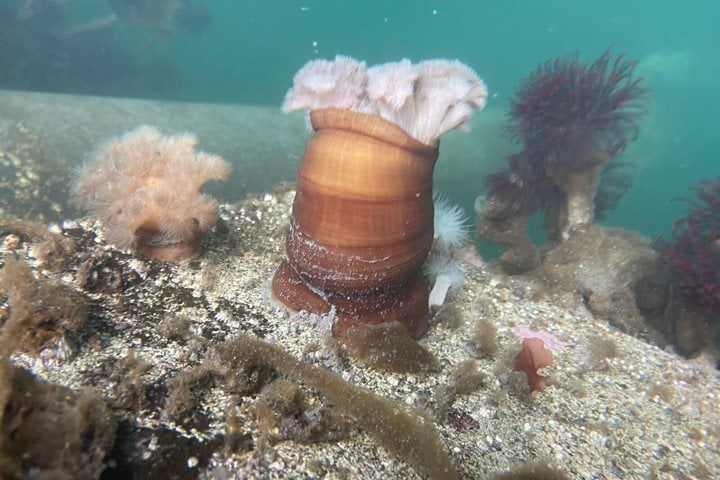National Geographic Sea Lion spent the early morning hours traveling out of Frederick Sound and into Chatham Strait, one of the world’s greatest fjords and more than 200 miles in length. Off the port side of the vessel land fog was hanging onto Baranof Island, making visibility tough at best, though humpback whales could be heard blowing nearby. We found ourselves on the bow and following the sound of whale breaths which carried over the sea very clearly in the still air. Above Sea Lion we could see clearing skies but our world continued to be water, fog and, slightly, the eastern shore of Baranof Island.
As we cruised north along the coast of Baranof Island we dipped into several small bays and finally reached our morning destination of Baranof Warm Springs and the home of our morning guest, Andy Szabo, one of Alaska’s leading researchers and experts on humpback whales. Andy was scheduled to give a presentation in the lounge and as he was setting up word came from the bridge that humpbacks had been spotted just ahead of our present position. After a brief discussion, our expedition leader and Andy decided that watching whales in their summer waters and not on a projected screen would be much more fun and also deeply enlighten our experience of marine mammals in Alaska. We all moved to the bow where we remained for the rest of the morning. The sun had moved clouds away, showing off snow-covered peaks on Baranof Island, not to mention lovely lacework designs on the face of Admiralty Island across Chatham Strait.
Shortly after assembling everyone on the bow, several whales were spotted gathering together a short distance ahead of us. Moving north along Baranof Island we watched as the whales surfaced, gathered more closely together and at one point we could see the fifteen-foot pectoral flippers reach out into the water as the animals dove sharply, one after another. All of a sudden six big-mouthed whales came to the surface, water splashing, herring flying in the air, and the bow also exploded with excitement. We were witnessing a sight very common to Southeast Alaska and very uncommon in other parts of the world: bubble-net feeding humpback whales! Over and over we watched as these marine mammals cooperatively organized themselves with very specific roles, created a bubble net, corralled a group of herring within the bubble net and then rose to the surface of the water, mouths agape, taking in what appeared to be fairly small amounts of fish! The whales remained on the surface for a brief time, then dove in the same order and repeated this process again and again.
Andy described behavior, answered questions, asked questions and generally moderated our observations of this rare sighting. His experience of the past 14 years, his sense of humor and his delight in our enjoyment of watching cooperative foraging humpback whales only added to and enhanced the entire morning. There were moments when the whales were under water and the bow would be nearly silent, birds could be heard on shore and then a rush would wash over the bow as the humpbacks came to the surface, cameras clicking, everyone cheering! It was a celebration of seeing something very rare and yet a learned behavior by a very small group of unrelated humpback whales that is a dramatic part of these northern Pacific waters.
After the enormous energy of the morning, retiring to forward lounge to view images and relaxing into conversation was a wonderful reprieve. Soon we were invited into the dining room for lunch. During dessert our expedition leader came forward and let us know the afternoon plans. Sea Lion had continued traveling north along the eastern side of Baranof Island heading toward our afternoon destination of Lake Eva, where kayaking and hiking would be offered for the remainder of the afternoon. Zodiacs were launched and soon all interested parties were ferried a short distance to the entrance to the Lake Eva hike. Long hikers led followed by mediums and leisure hikers all exploring the old-growth forest, a narrow strip of protected forest running along the salmon river leading to Lake Eva. Queen’s cup, spotted coral root, and bunch berry were all in full bloom. Bald eagles called from trees along with ravens, Steller jays and Pacific wrens filling the forest with another gift to the senses.
Meanwhile, radio calls began...bear in the inner tidal! As the hikes progressed throughout the afternoon the same brown bear continued to come in and out of the forest, explore the inner tidal, sit in the grass, and look out over its domain – this magnificent place of a 1,000 islands called Southeast Alaska.









